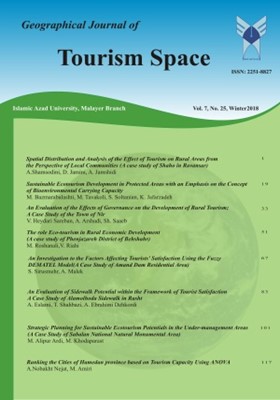Spatial Distribution of the Effect of Tourism on Rural Area From the perspective of Local communities (the Case of Shaho Town in Ravansar Township)
Subject Areas :
علی شمس الدینی
1
*
![]() ,
davood jomeini
2
,
alireza jamshidi
3
,
davood jomeini
2
,
alireza jamshidi
3
1 - هیات علمی دانشگاه آزاد اسلامی مرودشت
2 - isfahan
3 - ormiye
Keywords: Tourism, Rural Areas, spatial distribution, Effects of tourism, Shaho town,
Abstract :
Tourism Due to the various influences There are communities, Both urban and rural areas, In case of efficient management, Can Provide context for the development of host communities and In the absence of management and neglect, May underlie the problems and challenges of social, economic and environmental aspects in the host. The objective of this study is to present a spatial distribution of the effect of tourism on rural areas in Shaho, Ravansar. The population included all households (908 individuals) in 8 villages in Shaho town. Using Cochran’s formula, a sample of 206 individuals was selected for participating in this study. The instrument was a survey questionnaire validated by university professors and tourism professionals with its internal consistency estimated through Cronbach’s alpha. The data were analyzed using two software of SPSS and GIS. The results indicated that the effect of tourism was low on 38.3 percent, average on 30.1 percent, and high on 31.5 percent of the area. Analysis of variance showed that there is a meaningful difference among villages in terms of being effected by tourism. Duncan test indicated that Ghorighaleh with an average of 4.49 was the highest in the fourth level. Three villages of Tazehabad (M=2.66), Shabankareh (m=2.68), Benchaleh (2.81) in level three. GHalehgah (M=1.88), Chelaneh (M=1.90), Deh Leili (M=2.00) in the second level, and Bezgorah (M=1.27) was in the first level.
_||_

